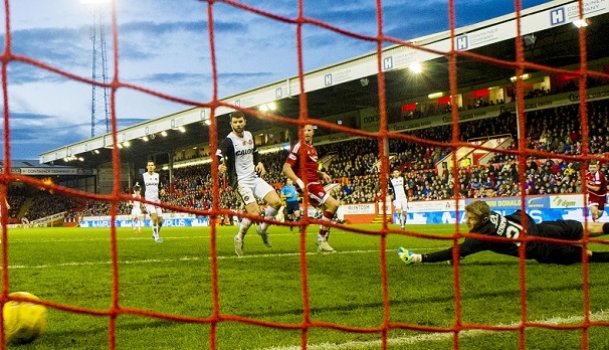Craig Cairns takes his latest tactical look at the SPFL, with the focus this week on Aberdeen, Hearts and Celtic.
Aberdeen concentrate their play down the left side
For the visit of Dundee United, Derek McInnes made the surprise decision to drop Niall McGinn to the bench. Peter Pawlett came in to replace him, playing in a central role behind Adam Rooney, meaning that Kenny McLean was fielded in a narrow position on the right.
Due to the absence of Andrew Considine through injury, Graeme Shinnie was moved to left-back. This gave Hayes the perfect partner on the left for taking the game to their opponents. Shinnie was not afraid to push forward, well beyond Hayes at times. The pair linked well together but Shinnie’s main aim, it seemed, was to overlap and occupy United’s right-back Sean Dillon, allowing Hayes to cross from deep.
Aberdeen were unlucky not to take the lead through Rooney via Hayes’ crossing at Celtic Park the previous week and scored a consolation goal from a set-piece involving the two. Their tactic on Saturday was to concentrate their play down the left, get the ball to Hayes as often as possible and get the Irishman to deliver the ball into the box as early and as often as possible.
Even though he was a lone striker, Rooney stationed himself in the inside-right channel in order to get on the end of Hayes’ dangerous back-post crosses. It was those two who again linked up to give Aberdeen the lead, even though it took the Dons a few seconds to bundle the ball into the net. It was also one of the first times Hayes headed for the byline and drilled in a low cross.
Hayes put his side further ahead (pictured) when he found himself in yards of space on the left after being fed by Pawlett. He opted to shoot rather than cross this time and saw the ball nestle in the bottom corner to secure the points.
Forrest and Griffiths find more space in the second half v County
Shortly after taking over as manager last season, Jim McIntyre decided to have a go at Celtic when they visited and saw his side easily turned over. This time he decided to tighten up, dropping striker Craig Curran for midfielder Ian McShane, instructing his side to sit deeper than they usually do at home and to hit their opponents on the break.
It almost worked, which may seem crazy given that they lost the game by three goals. Ross County denied Celtic space behind their defence, forced them wide and, for the most part, stopped their crosses. The little space behind their defence meant that Leigh Griffiths and James Forrest could not influence the game as much as they would have liked.
This forced Celtic into hitting long-range efforts. Tom Rogic opened the scoring with one after escaping the attention of Martin Woods, but it was the only time before the break that Celtic really looked like damaging County, despite their abundance of possession.
In fact, it was Ross County who had the three best chances of the first half – all of which came with the match still goalless. Liam Boyce put his free header wide, while Jackson Irvine and Woods would certainly have troubled Craig Gordon had the connection been better for their respective chances.
Shortly after the break, McShane had an excellent opportunity in which his first touch let him down. Not long after, Celtic extended their advantage with two goals from Griffiths. The Scotland striker had sent a warning shot moments before, forcing Gary Woods into a save. He was then - with the home side starting to push up the field a little more - able to find some space and curl the ball into the net.
Around a minute later, Forrest launched a counter attack, sprinting into the space he had been craving the entire first half before teeing up Griffiths for his second. County effectively nullified the threat of Forrest in the opening 45 minutes but played into his hands when they inevitably pushed forward more after the break.
Hearts’ 4-4-2 continues to dominate three-man central midfields
Robbie Neilson again tinkered with his formation, starting with a 4-3-3 but then switching quickly back to the 4-4-2 that has served him well in recent weeks - with Sam Nicholson and Arnaud Djoum either side of Prince Buaben and Morgaro Gomis. Hearts’ central midfield two were up against Hamilton’s three on Saturday - Martin Canning opting for a more reserved trio of Chris Turner, Darian MacKinnon and Greg Docherty in the absence of Ali Crawford.
Much like their recent home victory over Ross County, rather than being overrun, Hearts were able to dominate the centre of midfield by the way Djoum and Nicholson came inside. Neither was inclined to go towards the byline, with one exception in the case of Nicholson. This meant that, much like a 4-2-3-1, for instance, the two central midfielders can hold their position rather than run the risk of overcommitting – something a two in a standard 4-4-2 can sometimes force them to do.
You only have to look at the goals to see this at work. For the first, Nicholson makes a run from his left-wing position to the inside-right channel while Djoum is central and among the forwards. The Belgian did this repeatedly, including for his goal which he finished from the end of the six-yard box.
And, as has been the custom in recent weeks, this was all made possible by a solid defence. Hearts have now conceded just once in their last six league matches. Six and a half if you include the second half of the match versus Aberdeen, which coincides with Igor Rossi being moved from left-back to centre-back.





.png)












